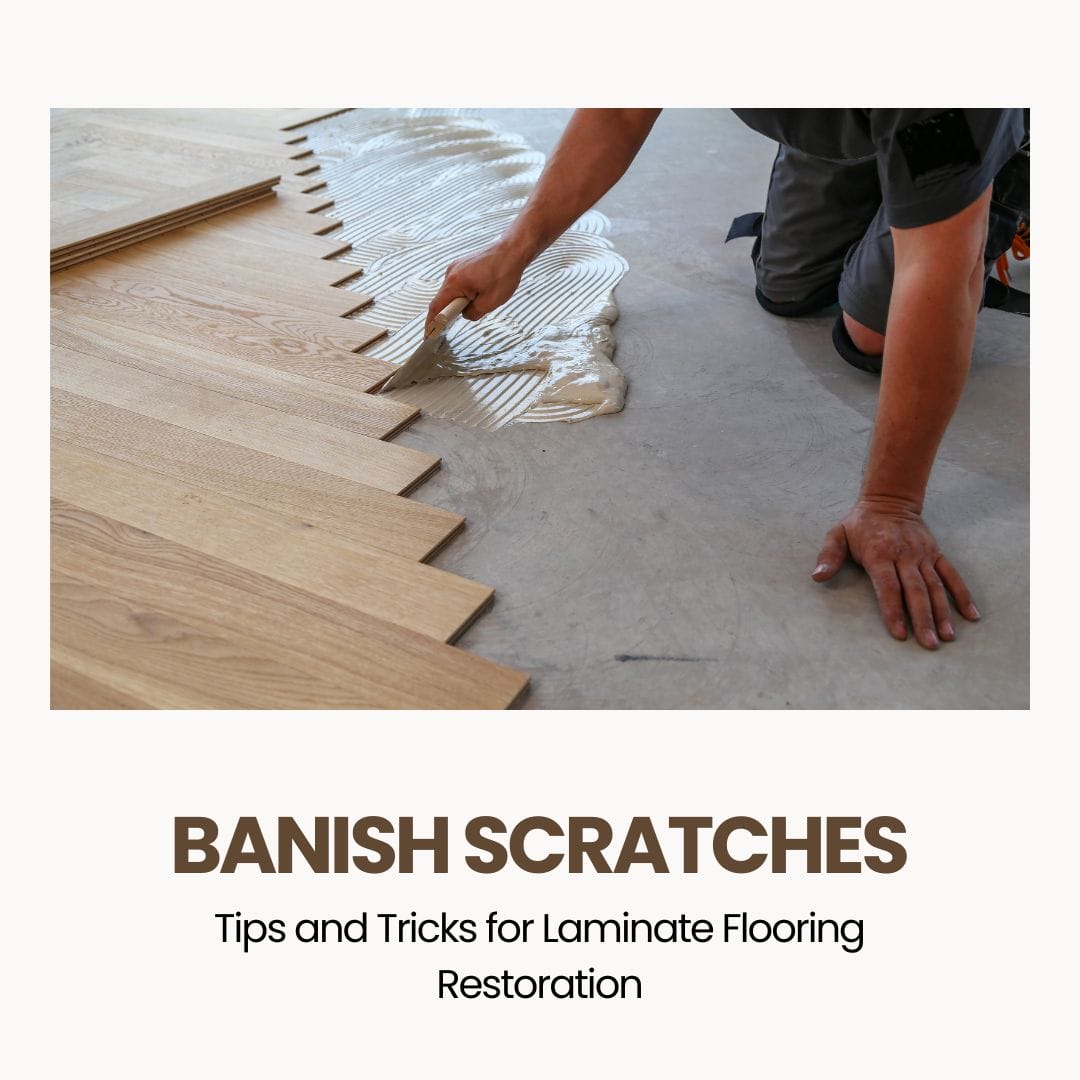Laminate flooring is not only durable and easy to maintain but also offers aesthetic flexibility. For ideas on creating a staggered pattern for laying the laminate flooring, see more Crafting a Perfect Stagger Pattern: A Guide to Laminate Floor Installation.
However one of the downsides of laminate flooring is that it can get scraped and scratched easily. Laminate flooring is not as durable as flooring made of materials like hardwood or tile.
You cannot sand, scrape, or scratch laminate flooring. It has to be repaired with floor repair putty or wax. If the damage is irreparable, you can replace it, which is a fairly affordable process.
Here, I will guide you on how to fix your laminate floor, but before we get on to repairing the floor, let’s understand what causes those scratches and how you can prevent them.
How Does Laminate Flooring Get Scratches?
You must know what is putting scratches on your laminate floors to avoid them in the future.
A laminate floor can get scratched when an abrasive surface rubs against it. For example, if you pull heavy furniture on the floor, the furniture’s legs can cause damage to your flooring.
Sometimes, pets like dogs and cats can scratch the laminate floors by digging their nails into the flooring panel. Also, dropping heavy or edged items on the laminate floor can cause scratching.
Read DIY Solutions for Laminate Flooring Woes: From Buckling to Chips
Deep Scratches
Deep scratches are usually caused by dropping something on the surface or furniture ends. Heavy machinery can also scratch laminate flooring.
To repair deeper scratches, you will need some filling and finishing to smoothen them and make them unnoticeable. If the scratch is too deep, seal it with scratch repair putty. Then you can add a protective layer over it by coating it with acetone.
Learn more about Hardwood Floor Dent Repair: Proven Techniques
Minor Scratches
A graze or high heels can cause minor scratches. They are simple and easy to fill. A quick touch-up can make them look normal.
You can fix these scratches with olive oil, walnut, or a wax/stain pen.
How to Get Scratches Out of Laminate Flooring?
The methods to fix scratches on laminate flooring mentioned here may not work on plastic laminate. A scratched plastic laminate cannot be repaired.
Wax Pencils
Wax pencils and markers are effective for fixing minor scuffs. You don’t have professional sketching skills to use a wax pencil to hide minor scratches. You can get a wax pencil from your local hardware store at an affordable price.
When you are buying a wax pencil, make sure you pick the color that matches your laminate floor. This will completely disguise the patchwork and give your floor a normal look.
To fix minor scratches with a wax pencil, stroke the pencil in the opposite direction of the scratched panel. Then rub it back and forth and wipe it with a dry, soft cloth to make the buff unnoticeable.
Stain Pen
Stain pens provide another easy go-to way for fixing scraped laminate floors. They are available in different colors and are super easy to use.
To fix scratches on the laminate floor, rub the stain pen on the scratches. Then you can apply a layer of varnish if needed. Wait for it to dry, and then wipe it with a cloth.
Discover Hardwood Floor Scratch Repair: DIY Techniques
Putty
Repair-colored putty works great for deeper scratches. Putty has a clay-like structure that can fill major scratches.
Repair putty is available in a variety of colors. You can get the color that matches your laminate flooring.
To repair your laminate floors with colored putty, remove some colored putty from the container using a putty knife. Fill in the scratch by applying putty onto the surface. Then use a wipe to remove the excess putty to blend the repair with the flooring. Then flatten the putty and let it dry.
See Our Guides
Crayon
Crayon is an easy and cost-effective way to fix laminate floor scratches. To repair laminate floor scuffs, melt crayons and fill the scrapes with the melted crayons.
To make sure your floor has a natural/normal look, use the crayons that match your laminate floor color. If you cannot find matching crayons, you can mix up different crayon colors to get the color you want.
Let the crayon dry in the scratches. Then gently scrape excess crayons using a putty knife at 45 degrees from the floor.
Johnson’s Paste Wax
Paste wax is generally used to repair dents and scratches on hardwood flooring, but it is also effective for hiding scratches on laminate flooring.
Fixing scratches with paste wax is as simple as finding the right color and finish and applying it to the scraped area. Then flatten it and remove excess wax using a putty knife. Let it dry and, if needed, apply a finisher to it.
Olive Oil Rubbing
Dipping a piece of cotton in olive oil and rubbing it on the scratch marks can make them less noticeable. It turns the scrapes lighter in color and blends them into the floor.
This method is an easy and quick fix for new scratches. The best part of using this method is that you will not have to make much effort, and it works like magic.
Walnut Rubbing
Coating scratches on your laminate floors with walnuts will hide them and make them unnoticeable, like olive oil.
Rubbing walnuts on the scratches for 3-5 minutes disguises them on the floor. However, ensure you rub the walnut back and forth toward the scratch. You will make the scratch even broader if you rub it across the scratch.
Toothpaste Rubbing
This method isn’t very popular but works well for minor scratches. To work this method, dab the toothpaste on scratch marks and keep dabbing till the marks disappear from the laminate wood floors. Then remove the toothpaste residue using water and vinegar solution and let it dry.
Burn-in Sticks With Repair Kits
A laminate floor repair kit is specially designed to repair your laminate floor scratches and other damages. It comes with Burn-in Sticks of different colors, markers, battery-powered melting tools, towels, cleaning solutions, and knives. The contents of the Burn-in Sticks repair kit may vary from kit to kit.
Follow these steps to repair your laminate floors with the Burn-in Sticks repair kit:
- If there are splinters around the damage, cut them with the help of a putty knife. Place the knife at 45 degrees from the floor to prevent any further damage to the floor.
- Melt the sticks with the help of battery-powered melting tools in the kit. Make sure you combine different sticks to match the color of the floor.
- Melt lighter shade melted burn-in sticks first, and then add darker melted burn-in sticks. This allows you to rectify if the color of melted burn-in sticks does not match the floor color.
- Add more white sticks to make the shade lighter. Add a few drops of darker melted sticks to make the shade darker.
- Let it dry for a while.
- Then sand the patch with fine-grit sandpaper to make it leveled.
- Use a dry cloth to wipe the area clean.
- If your repair kit has a clear lacquer or varnish, apply it to get a protective layer and shiny finish. When applying varnish, ensure you get proper ventilation in the area.
How to Prevent Scratches on Your Laminate Flooring?
There are several ways to avoid scratches on your laminate flooring.
Install Furniture Pads
Furniture pads are installed beneath the furniture. These pads act as a cushion between the furniture and the floor to help prevent damage to the floor. They allow you to move furniture around without damaging the floor.
You should buy these pads if your furniture ends are sharp and small or if you move furniture often.
Use Rugs
Floor mats and rugs are beneficial no matter what kind of flooring you have. It will protect your laminate flooring from damage, especially in the high-traffic area.
Plastic Flooring Pads
Plastic flooring pads go on the floor in an office setting. It prevents damage to the flooring from moving a chair or table. You can purchase plastic flooring pads in your dining room.
Trim Pet Nails
Pet nails can damage your laminate floors as well. They are playful and ignorant of human concerns. If they scratch a lot and are untrained, consider trimming their nails.
Limit Excess Moisture
Moisture can cause laminate planks to expand and swell. Try limiting the moisture in the surroundings to avoid this. The recommended humidity level for laminate floors is 35% to 65%.
Heavy Machinery
Using or moving heavy machinery can cause damage to laminate planks. If you laminate the floor, try not to bring heavy machinery inside. If you have to bring heavy machinery, make sure you use padding to prevent any damage to the floor.
Regular Cleaning and Maintenance
Mopping and sweeping the floor regularly will remove the debris and dust from causing scratches to the floor.
Anti-Scratch Laminate Pads
Anti-scratch laminate pads help keep your floor scratch-free. They are affordable and are pretty scrape-resistant. They make your floor immune to further scratches.
Replacing Planks
If the damage on your laminate floor is irreparable or none of the above methods worked for you, you should consider replacing the planks. If you want to replace a laminate plank, here is how you do it:
Remove the Baseboard
The baseboard is what holds the planks in place. They are at the corner of the wall. The planks are screwed beneath the baseboard to the underlayment. You have to remove these screws to pull out the planks.
Take Out the Surrounding Planks
One of the major benefits of laminate planks is that they are easy to install and remove. You can easily remove damaged planks and replace them with a new one. You do not have to call a professional to do this job. You have to remove the surrounding planks to get to the desired one.
Replace the Damaged Plank
Replace the damaged plank with a new one. Then place the other removed planks back and install the baseboard back.


